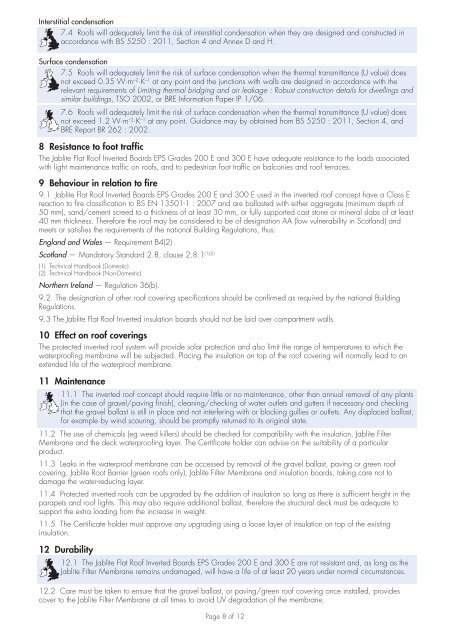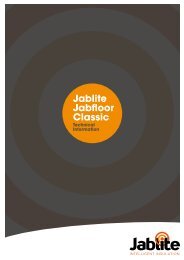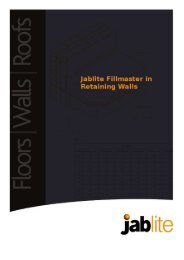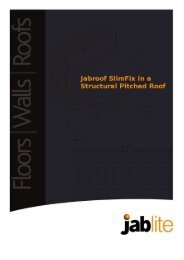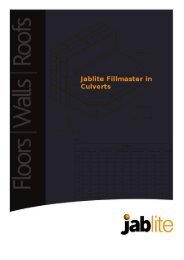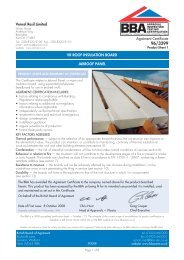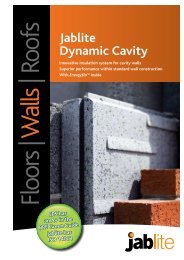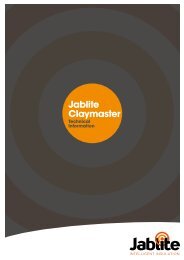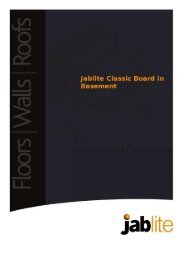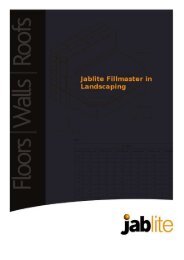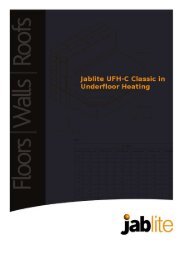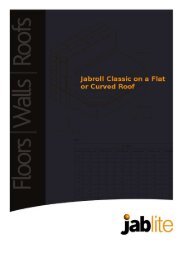Jablite Flat Roof Inverted Boards EPS Grades 200 E and 300 E
Jablite Flat Roof Inverted Boards EPS Grades 200 E and 300 E
Jablite Flat Roof Inverted Boards EPS Grades 200 E and 300 E
Create successful ePaper yourself
Turn your PDF publications into a flip-book with our unique Google optimized e-Paper software.
Interstitial condensation7.4 <strong>Roof</strong>s will adequately limit the risk of interstitial condensation when they are designed <strong>and</strong> constructed inaccordance with BS 5250 : 2011, Section 4 <strong>and</strong> Annex D <strong>and</strong> H.Surface condensation7.5 <strong>Roof</strong>s will adequately limit the risk of surface condensation when the thermal transmittance (U value) doesnot exceed 0.35 W·m –2·K–1 at any point <strong>and</strong> the junctions with walls are designed in accordance with therelevant requirements of Limiting thermal bridging <strong>and</strong> air leakage : Robust construction details for dwellings <strong>and</strong>similar buildings, TSO <strong>200</strong>2, or BRE Information Paper IP 1/06.7.6 <strong>Roof</strong>s will adequately limit the risk of surface condensation when the thermal transmittance (U value) doesnot exceed 1.2 W·m –2·K –1 at any point. Guidance may by obtained from BS 5250 : 2011, Section 4, <strong>and</strong>BRE Report BR 262 : <strong>200</strong>2.8 Resistance to foot trafficThe <strong>Jablite</strong> <strong>Flat</strong> <strong>Roof</strong> <strong>Inverted</strong> <strong>Boards</strong> <strong>EPS</strong> <strong>Grades</strong> <strong>200</strong> E <strong>and</strong> <strong>300</strong> E have adequate resistance to the loads associatedwith light maintenance traffic on roofs, <strong>and</strong> to pedestrian foot traffic on balconies <strong>and</strong> roof terraces.9 Behaviour in relation to fire9.1 <strong>Jablite</strong> <strong>Flat</strong> <strong>Roof</strong> <strong>Inverted</strong> <strong>Boards</strong> <strong>EPS</strong> <strong>Grades</strong> <strong>200</strong> E <strong>and</strong> <strong>300</strong> E used in the inverted roof concept have a Class Ereaction to fire classification to BS EN 13501-1 : <strong>200</strong>7 <strong>and</strong> are ballasted with either aggregate (minimum depth of50 mm), s<strong>and</strong>/cement screed to a thickness of at least 30 mm, or fully supported cast stone or mineral slabs of at least40 mm thickness. Therefore the roof may be considered to be of designation AA (low vulnerability in Scotl<strong>and</strong>) <strong>and</strong>meets or satisfies the requirements of the national Building Regulations, thus:Engl<strong>and</strong> <strong>and</strong> Wales — Requirement B4(2)Scotl<strong>and</strong> — M<strong>and</strong>atory St<strong>and</strong>ard 2.8, clause 2.8.1 (1)(2)(1) Technical H<strong>and</strong>book (Domestic).(2) Technical H<strong>and</strong>book (Non-Domestic)Northern Irel<strong>and</strong> — Regulation 36(b).9.2 The designation of other roof covering specifications should be confirmed as required by the national BuildingRegulations.9.3 The <strong>Jablite</strong> <strong>Flat</strong> <strong>Roof</strong> <strong>Inverted</strong> insulation boards should not be laid over compartment walls.10 Effect on roof coveringsThe protected inverted roof system will provide solar protection <strong>and</strong> also limit the range of temperatures to which thewaterproofing membrane will be subjected. Placing the insulation on top of the roof covering will normally lead to anextended life of the waterproof membrane.11 Maintenance11.1 The inverted roof concept should require little or no maintenance, other than annual removal of any plants(in the case of gravel/paving finish), cleaning/checking of water outlets <strong>and</strong> gutters if necessary <strong>and</strong> checkingthat the gravel ballast is still in place <strong>and</strong> not interfering with or blocking gullies or outlets. Any displaced ballast,for example by wind scouring, should be promptly returned to its original state.11.2 The use of chemicals (eg weed killers) should be checked for compatibility with the insulation, <strong>Jablite</strong> FilterMembrane <strong>and</strong> the deck waterproofing layer. The Certificate holder can advise on the suitability of a particularproduct.11.3 Leaks in the waterproof membrane can be accessed by removal of the gravel ballast, paving or green roofcovering, <strong>Jablite</strong> Root Barrier (green roofs only), <strong>Jablite</strong> Filter Membrane <strong>and</strong> insulation boards, taking care not todamage the water-reducing layer.11.4 Protected inverted roofs can be upgraded by the addition of insulation so long as there is sufficient height in theparapets <strong>and</strong> roof lights. This may also require additional ballast, therefore the structural deck must be adequate tosupport the extra loading from the increase in weight.11.5 The Certificate holder must approve any upgrading using a loose layer of insulation on top of the existinginsulation.12 Durability12.1 The <strong>Jablite</strong> <strong>Flat</strong> <strong>Roof</strong> <strong>Inverted</strong> <strong>Boards</strong> <strong>EPS</strong> <strong>Grades</strong> <strong>200</strong> E <strong>and</strong> <strong>300</strong> E are rot resistant <strong>and</strong>, as long as the<strong>Jablite</strong> Filter Membrane remains undamaged, will have a life of at least 20 years under normal circumstances.12.2 Care must be taken to ensure that the gravel ballast, or paving/green roof covering once installed, providescover to the <strong>Jablite</strong> Filter Membrane at all times to avoid UV degradation of the membrane.Page 8 of 12


